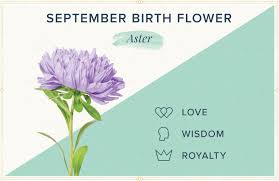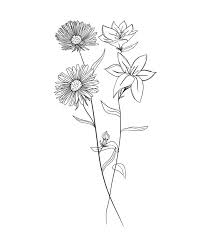September births are blessed with a stunning array of birth flowers that reflect the vibrant transition from summer to autumn. The two primary flowers associated with this month are the aster and the morning glory, each possessing its own unique beauty and symbolism.
These blossoms not only make remarkable gifts for September-born individuals but also offer fascinating insights into their personalities and the significant moments of their lives.
The aster, with its delicate petals and captivating colors, is often hailed as the September birth flower in the Western tradition. Its name derives from the Greek word “astron,” meaning star, which perfectly captures its striking resemblance to a celestial body. These flowers typically bloom in shades of pink, purple, blue, and white, and are known for their vibrant centers that resemble tiny golden stars.
The aster is rich in symbolism, representing love, patience, and elegance. It is believed to convey deep affection and an appreciation for the finer things in life. In ancient times, the aster was considered a talisman that brought good fortune and protection against evil.
Additionally, this flower symbolizes wisdom, which resonates strongly with September-born individuals known for their sharp intellect and ability to analyze situations with clarity.
Furthermore, the aster holds special significance in certain cultures. In China, it is associated with the harvest season and is thought to bring joy, good luck, and prosperity. In some Native American traditions, asters are viewed as magical flowers that possess healing properties, making them highly valued in herbal medicine and spiritual rituals.
Alongside the aster, the morning glory stands as another symbolic September birth flower, revered for its enchanting beauty and ethereal charm. These trumpet-shaped blossoms are famous for their exquisite shades of blue, purple, pink, and white, often boasting intricate patterns that resemble swirling galaxies. The morning glory’s name pays homage to its delicate nature, as its flowers typically unfurl in the early morning and close as the day progresses.
Morning glories symbolize love, affection, and transformation. They embody the idea of seizing the day and cherishing every fleeting moment. Their vibrant colors and ephemeral nature remind us to appreciate the beauty around us and embrace the ever-changing cycles of life.
Morning glories are also associated with spirituality and the pursuit of enlightenment, making them an ideal representation of the introspective nature often found in September-born individuals.
In Japanese folklore, morning glories are believed to possess the power to ward off evil spirits and bring good luck and happiness to households. They are revered for their ability to grant wishes and are often grown near entrances as a protective charm. The Japanese name for morning glory, “asa-no-ha,” also signifies the start of a new day, making it a symbol of hope and new beginnings.
Whether it’s the captivating aster or the enchanting morning glory, September birth flowers offer a tapestry of beauty and meaning. As gifts, these blossoms carry heartfelt messages of love, admiration, and appreciation for the September-born individuals in our lives.
They serve as a reminder of the unique qualities and inherent strengths possessed by those born during this time, and the wonderful experiences that lie ahead for them.
So, as September approaches, let us celebrate the birth month with these exquisite flowers, embracing their symbolism and acknowledging the extraordinary individuals they represent. May the asters and morning glories bloom in our lives, infusing them with beauty, grace, and the promise of a vibrant future.
Read Also: Babys Breath Flowers (Gypsophila Paniculata): Complete Growing and Care Guide
History and Significance of September Birth Flowers

The aster, considered the primary birth flower for September in Western traditions, has a fascinating history that dates back centuries. Its name originates from the Greek word “astron,” which means star. According to Greek mythology, asters were believed to have emerged from the tears of the Greek goddess Astraea, who wept for the lack of stars on Earth. These celestial flowers were considered a gift from the heavens, representing purity and elegance.
In the language of flowers, asters carry various meanings. They are commonly associated with love, patience, and daintiness. A bouquet of asters is often given as a symbol of affection and devotion. Additionally, asters are seen as a representation of wisdom and intelligence, making them a fitting choice for those born in September, who are known for their analytical minds and inquisitive nature.
The aster’s significance extends beyond Western cultures. In China, the aster holds deep cultural and agricultural significance. During the Mid-Autumn Festival, which typically falls in September, asters are prominently displayed to celebrate the bountiful harvest. They symbolize joy, good luck, and prosperity, and are an integral part of the festive decorations.
Native American cultures also attribute special meanings to asters. Some tribes considered asters as magical flowers with healing properties. They were used in herbal remedies and spiritual rituals to bring about physical and emotional well-being. The asters’ enchanting blooms were thought to ward off negative energies and promote positivity.
In contrast to the aster, the morning glory holds its own unique history and symbolism as a September birth flower. Morning glories have a long-standing association with transformation and new beginnings. Their name alludes to their ephemeral nature, as the flowers unfurl in the morning and fade away as the day progresses.
In Japanese folklore, morning glories are seen as symbols of hope and the start of a new day. The Japanese name for morning glory, “asa-no-ha,” translates to “leaves of the morning,” signifying the belief that each day brings with it new opportunities and possibilities.
Morning glories are also thought to possess the power to ward off evil spirits and bring good luck and happiness to households. In Japan, they are often planted near entrances as a protective charm.
The morning glory’s significance extends to other cultures as well. In Victorian floriography, the language of flowers popular during the 19th century, morning glories represented affection and love. They were seen as a romantic gesture, symbolizing deep emotions and the pursuit of romantic relationships.
Both the aster and the morning glory, as September birth flowers, carry profound historical and cultural significance. They represent love, transformation, intelligence, and hope. These exquisite blooms connect us to ancient beliefs and traditions, reminding us of the enduring power of nature’s beauty and the profound impact flowers can have on our lives.
Whether given as a heartfelt gift or admired in gardens, asters and morning glories continue to enchant and inspire, celebrating the unique qualities of September-born individuals and the richness of the human experience.
Uses of September Birth Flowers

September birth flowers, the aster and the morning glory, have found various uses and applications beyond their symbolic significance. Let’s explore some of the practical and creative uses of these beautiful blooms.
1. Floral Arrangements: Asters and morning glories make stunning additions to floral arrangements. Their vibrant colors and unique shapes add depth and visual interest to bouquets, centerpieces, and floral displays. Mixed with other seasonal flowers, they create captivating arrangements for birthdays, weddings, and special occasions.
2. Home Decor: Dried asters and morning glories can be incorporated into decorative wreaths, dried flower arrangements, and potpourri. These preserved blooms retain their colors and delicate forms, allowing you to enjoy their beauty throughout the year. Their presence brings a touch of nature indoors, adding warmth and charm to any living space.
3. Gardening: Asters and morning glories are popular choices for home gardening enthusiasts. With a wide range of varieties available, they can be grown in gardens, flower beds, or containers. Asters, known for their late-season blooms, are valued for providing color and attracting pollinators well into autumn. Morning glories, with their climbing vines, are often cultivated to adorn trellises, fences, or pergolas, creating a picturesque display of blossoms.
4. Medicinal Purposes: In traditional medicine, asters and morning glories have been used for their potential healing properties. Certain aster species have been utilized in herbal remedies to treat respiratory conditions, digestive issues, and inflammation. Morning glories have been studied for their alkaloid content, which may have therapeutic effects. However, it is essential to consult with a qualified herbalist or healthcare professional before using any plant for medicinal purposes.
5. Cultural Celebrations: The significance of asters and morning glories in cultural celebrations cannot be overlooked. In festivals and events honoring the harvest season, asters are used for decorative purposes, symbolizing abundance, luck, and joy. Morning glories are often incorporated into traditional ceremonies and rituals, representing new beginnings, hope, and spiritual protection.
6. Symbolic Gifts: A bouquet or arrangement of asters or morning glories can serve as a thoughtful gift for individuals born in September. These flowers carry deep symbolism associated with love, affection, transformation, and wisdom. They can be presented on birthdays, anniversaries, or as tokens of appreciation, conveying heartfelt messages and well wishes.
7. Artistic Inspiration: The delicate forms, vibrant colors, and intricate patterns of asters and morning glories have inspired artists, poets, and craftsmen throughout history. These flowers have been depicted in paintings, sculptures, textiles, and other artistic mediums, capturing their beauty and allure. They continue to be a muse for creative expression, reflecting the profound impact of nature’s creations on human imagination.
The uses of September birth flowers extend beyond their symbolic representations, enriching our lives through their aesthetic appeal, practical applications, and cultural associations. Whether enjoyed in floral arrangements, utilized in gardening endeavors, or incorporated into artistic pursuits, asters and morning glories serve as reminders of the inherent beauty and versatility found in the natural world.
Read Also: Snapdragon Flowers (Antirrhinum Majus): Complete Growing and Care Guide
September Birth Flowers Complete Growing Guide

If you’re interested in cultivating September birth flowers, asters and morning glories, in your garden or as potted plants, this comprehensive growing guide will provide you with the essential information to help you succeed.
Growing Asters:
1. Planting: Asters thrive in well-draining soil and prefer full sun or partial shade. Choose a location in your garden that receives at least 6 hours of direct sunlight per day. Plant asters in spring or early summer, following the last frost date in your region.
2. Soil Preparation: Prepare the soil by removing any weeds or debris. Asters prefer moist but well-drained soil. Improve the soil’s drainage by adding organic matter, such as compost or well-rotted manure.
3. Planting Method: Dig a hole slightly larger than the root ball of the aster plant. Place the plant in the hole, making sure the crown (where the stem meets the roots) sits at ground level. Backfill the hole with soil, gently firming it around the plant. Space asters according to the recommended distance for the specific variety you’re planting.
4. Watering: Water the newly planted asters thoroughly to help establish their roots. Keep the soil consistently moist but avoid overwatering, as asters are susceptible to root rot. Water deeply whenever the top inch of soil feels dry, especially during dry spells or hot weather.
5. Fertilization: Apply a balanced, slow-release fertilizer in spring as new growth appears. Follow the manufacturer’s instructions for the appropriate dosage. Avoid excessive nitrogen fertilizers, as they can lead to leggy growth and reduced flowering.
6. Pruning: Pinch back the tips of young aster plants when they reach about 6 inches in height. This encourages bushier growth and more abundant blooms. Deadhead spent flowers regularly to prolong the blooming period and maintain a tidy appearance.
7. Pest and Disease Control: Asters are generally resilient plants but may occasionally be affected by pests such as aphids or powdery mildew. Monitor your plants regularly and take appropriate action if infestations occur. Organic insecticidal soaps or horticultural oils can be used for pest control, while ensuring proper air circulation around the plants can help prevent fungal diseases.
Growing Morning Glories:
1. Planting: Morning glories are annual vines that are best planted directly in the ground or in containers after the danger of frost has passed. They prefer full sun and well-drained soil.
2. Soil Preparation: Prepare the soil by removing weeds and loosening it with a garden fork or tiller. Morning glories are adaptable to different soil types but prefer fertile, loamy soil. Add organic matter, such as compost or aged manure, to improve soil fertility and drainage.
3. Planting Method: Soak morning glory seeds in warm water for a few hours before planting to help soften the hard seed coat. Plant the seeds about ½ inch deep in the soil, spacing them according to the recommended distance for the specific variety. If planting in containers, use a well-draining potting mix.
4. Watering: Keep the soil consistently moist until the seeds germinate, which usually takes around 7 to 10 days. Once established, morning glories are relatively drought-tolerant and prefer slightly drier conditions. Water deeply when the soil feels dry to the touch, but avoid overwatering, as it can lead to root rot.
5. Support and Training: Morning glories are climbing vines that require support structures, such as trellises, fences, or arbors. Install the supports at planting time or shortly after, as the vines will quickly start twining and attaching themselves. Guide the growing vines to the support structure, gently wrapping them around or tying them as needed.
6. Fertilization: Morning glories generally do not require heavy fertilization. Excessive nitrogen can promote leafy growth at the expense of flowers. If desired, a balanced fertilizer can be applied sparingly during the growing season, following the manufacturer’s instructions.
7. Pest and Disease Control: Morning glories are generally resistant to pests and diseases. However, keep an eye out for common garden pests, such as aphids or spider mites, and treat as necessary using appropriate organic methods. Provide adequate air circulation by spacing plants properly to minimize the risk of fungal diseases.
By following these guidelines, you can enjoy the beauty of asters and morning glories in your garden or as potted plants. With proper care and attention, these September birth flowers will reward you with their vibrant colors and graceful blooms throughout the growing season.
Read Also: Educational Infant Toys: Enhancing Cognitive Development from Day One
